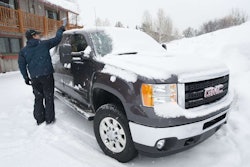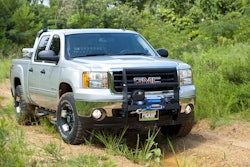 ALL ABOUT SHOCKS
ALL ABOUT SHOCKS
Sometimes it’s the simplest parts that make the biggest difference in a truck’s performance and efficiency; worn-out shocks lead the way
by Bruce W. Smith
It wasn’t to the point of needing a Dramamine patch behind the ear, but the pickup I was driving back from a jobsite for a friend rode and handled a lot more like a yacht in heavy seas than a stable work truck.
A glance at the odometer between swells shed some light on the truck’s boat-like ride: 47,530 miles.
 Shocks pistons and seals wear out slowly so their demise isn’t always obvious to the pickup owner.
Shocks pistons and seals wear out slowly so their demise isn’t always obvious to the pickup owner.
Most of those miles, I suspected, were over twisty gravel country roads, road build sites and pot-hole-ridden city streets.
Perfect driving conditions that hasten the wear and tear of any pickup’s suspension – right down to the shocks.
This pickup’s owner, like most contractors on a tight budget, kept the oil and filters changed regularly.
Other repairs, however, are only done on an “as needed” basis; if a part was obviously worn out or broken it was replaced. Otherwise, drive on.
The problem with such thinking is some parts don’t always show signs they are shot.
Shocks are a perfect example because they wear out so slowly their demise doesn’t ring any alarms until they fall off or break.
Shocks, like tires, give warning signs long before they fall off. You just need to know what to look for, such as a wallowing in corners, continued bouncing after driving through a dip, clunking when the truck hits a pothole, as well as cupped or scalloped tire wear.
GAUGING SHOCK WEAR
You can also let the odometer be your shock replacement gauge:
“As a general rule of thumb, OEM hydraulic twin-tube shocks only last about 15,000 to 20,000 miles when used in a work truck environment (towing, hauling heavier loads, off-road/off-pavement use),” says Shane Casad, Bilstein of America, who specializes in pickup suspension setups.
 High-quality off-road shocks have stronger tube construction and internal components than most OEM shocks.
High-quality off-road shocks have stronger tube construction and internal components than most OEM shocks.
“Of course, a shock’s life expectancy will vary depending on how far the vehicle is driven and how much of that is rugged off-pavement use.
A lot of the latter could result in factory shocks lasting less than 10,000 miles.”
According to Casad and other shock experts, low-pressure gas-filled OE shocks, like those found under some of the factory “off-road” suspension packages, are good for about 25,000 miles.
After that shocks are just along for the ride – as are those under the pickup I’m driving.
Worn-out shocks no longer control the vehicle when a big dip in the road swallows it up, nor do they quickly steady the wobbles, bounces and shakes after crossing the railroad tracks or when a trailer is on the hitch.
Bad shocks also contribute to accelerated and uneven tire wear.
So don’t be quick to blame the “new” tires if they seem to wear faster than the ones they replaced.
Shot shocks (and struts) will also hasten the wear of the front suspension from ball joints to A-arms and CV joints.
The fix is easy: replace the shock/struts with new ones.
SHOCKS AND ROI
But before you call the local parts house or your pickup dealer consider the ROI between cheap shocks, OEM replacements, and high-end off-road shocks.
Cheap shocks are going to need replacing again after 15,000 or 20,000 miles, whereas high-quality aftermarket replacements may last three to four times longer.
You drop $100 on four cheap shocks and an hour or more in shop labor for R&R. Six months later you are doing it all over again.
During a 100,000-mile cycle that could result in four sets of shocks and six hours of shop labor and several days of the pickup being out-of-service.
Spending $400 on good off-road shocks takes the same R&R time. But it’s a one-time deal in the same cycle period.
Some performance pickup shocks, like those offered by QA1, BDS, Pro Comp and Bilstein, carry a limited lifetime warranty, further reducing ROI.
A SAFER VEHICLE
Another reason to spend the money on the best shocks available for your pickup is they improve ride and handling, loaded or empty, thus increasing driver control and reducing driver fatigue. A more alert driver that has better vehicle control is a safer driver.
The difference in longevity and vehicle control is related directly to the quality of the components.
“Usually a premium gas-pressure shock, such as a Bilstein, is composed of higher quality components resulting in tighter tolerances and long-lasting seals, resulting in less wear to moving parts,” explains Casad.
“There’s also more technology employed to control shock fade, oil cavitation and heat dissipation more efficiently, extending overall performance life.”
Controlling cavitation and heat, which leads to shock fade, is critical to vehicle ride and control when the road turns to washboard or there’s a heavy equipment trailer in tow.
So is ensuring the shock can handle being subjected to the rigors of heavy construction environments.
High-quality off-road shocks have stronger tube construction and internal components than either OEM shocks or low- to mid-priced aftermarket replacements. (You really do get what you pay for when it comes to shocks.)
Strong tube design is critical in providing resistance to dents caused by flying debris while the more expensive piston and rod components resist rusting, pitting and flaking that leads to internal failure.
GOING HIGH-TECH
One upgrade to consider is off-road shocks with remote oil reservoirs. shocks such as the Bilstein 5160 have evolved from desert racing and are now priced – and designed – to be used on pickups working in oil/gas fields, off-highway road builds and heavy towing apps.
The remote reservoir delivers far better suspension control than standard off-road shocks and eliminates the chances of shock fade in the most demanding off-pavement driving conditions.
Regardless of the shocks installed, contractors should always make sure shock boots are in place according to Roger Wilson, QA-1 vice president of motorsports.
“Keeping the shock’s piston rod clean is critical to any shock’s longevity. Shock boots protect the piston rod from flying debris, dirt, dust and mud, extending shock life.
Replacing a torn shock boot costs about $3. Figuring out the ROI on that is easy.”
High-quality off-road shocks are designed for the very environment ProPickup readers work in every day. So take advantage of the technology – and enjoy the ride.







